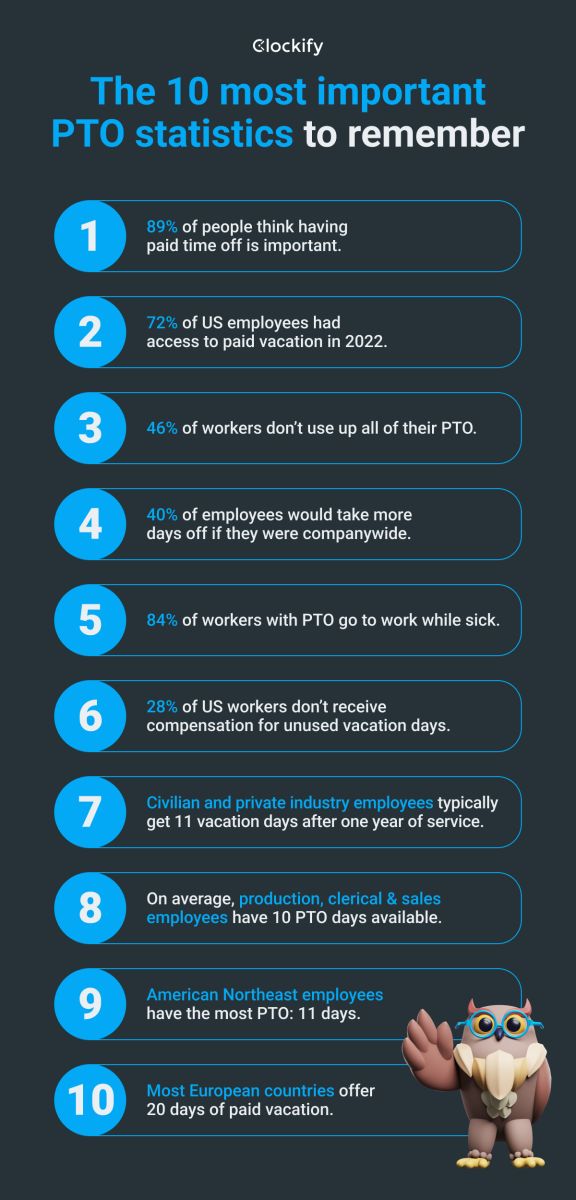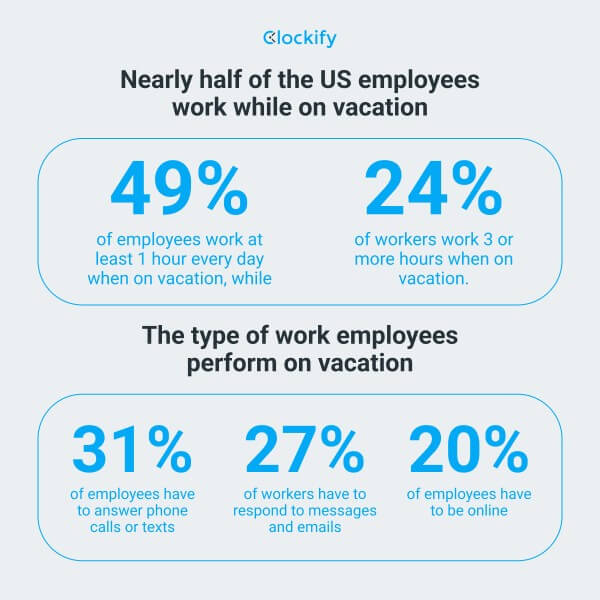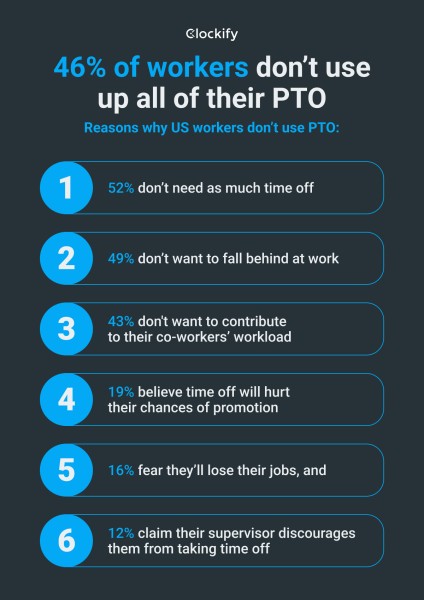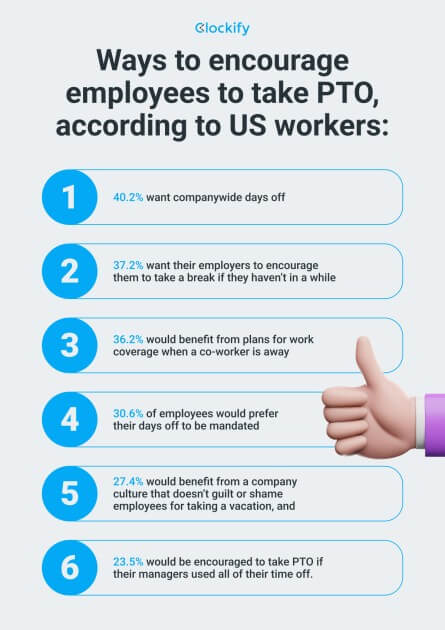What is the average PTO in the USA? Key PTO statistics for 2023
A 2023 survey by the Pew Research Center showed that 46% of US workers don't use up all of their paid time off (PTO) despite the majority of employees believing having paid time off is important.
But what is the reason behind so many US employees abstaining from using all their PTO, and what exactly is good PTO in the USA?
Well, if you want to know what the average PTO in the US is, how much time off employees of different industries have, as well as how the US compares to the rest of the world, you've come to the right place!

PTO statistics: 10 most important stats
PTO, or the time you take off from work without any loss of pay, is a common benefit that contributes to millions of workers around the world feeling valued and appreciated.
Let's take a look at the 10 most important PTO statistics to see whether the numbers reflect that:
- 89% of people think having paid time off is important.
- 72% of US employees had access to paid vacation in 2022.
- 46% of workers don't use up all of their PTO during the year.
- 40% of employees would take more days off if they were company-wide.
- 84% of workers with PTO go to work while sick.
- 28% of US workers don't receive compensation for unused vacation days.
- Civilian and private industry employees typically get 11 vacation days after one year of service.
- On average, production, clerical & sales employees have 10 PTO days available.
- American Northeast employees have the most PTO: 11 days per year.
- Most European countries offer 20 days of paid vacation.

What is good PTO in the USA: The average PTO in the US
The federal law does not require employers to offer any paid time off to their employees. Therefore, PTO is a matter of employment contract.
Still, along with the details agreed on in contracts, the average PTO in the US depends on various factors, with the most important ones being:
- The type of service (civilian, private industry, and state or local government employment), and
- Years of service.
Moreover, the type of PTO plan (consolidated or separate leave policies) greatly impacts the number of days off employees have available per year.
A consolidated leave plan incorporates all types of leave within one policy. On the contrary, some employers offer separate leave policies for different types of leave, such as:
- Sick leave,
- Personal time off,
- Vacation leave, and
- Family and medical leave.
Unlike consolidated leave plans, which provide employees with a cumulative number of days off they can use as they see fit, separate leave policies offer them a limited number of days off available for different types of leaves. Here's the average PTO in the US depending on the type of service and PTO plan employees have.
The average PTO in the USA for consolidated leave plans
According to the official US Bureau of Labor of Statistics numbers, the average paid time off in the US for civilian and private industry employees with consolidated leave plans per year is:
- 14 days after 1 year of employment,
- 18 days after 5 years of service,
- 20 days after 10 years of work, and
- 23 days after 20 years of service.
Furthermore, the average PTO in the US for government workers with consolidated leave plans per year is:
- 18 days after 1 year,
- 21 days after 5 years,
- 24 days after 10 years, and
- 27 days after 20 years.
The average paid sick leave in the USA
An average civilian employee with a separate sick leave plan gets a total of 8 paid sick days per year, regardless of years of service.
An average private industry worker has 7 paid sick days per year available, no matter how long they've been employed.
On the other hand, the average number of paid sick days for government workers highly depends on the years of service. Government employees receive an average of:
- 11 sick days per year after 1 year of employment, and
- 12 sick days per year after 5 years of employment.
The average number of vacation days in the USA
The average vacation days per year (as a separate leave plan) also depend on the type of service and years of employment.
The US Bureau of Labor Statistics reports that civilian and private industry employees typically get:
- 11 days per year after 1 year of service,
- 15 days per year after 5 years of service,
- 18 days per year after 18 years of employment, and
- 20 days per year after 20 years of service.
How many vacation days you get as a government employee also depends on the years of service. An average state or local government worker yearly receives:
- 12 days per year after 1 year,
- 16 days per year after 5 years,
- 19 days per year after 10 years, and
- 22 days per year after 20 years of service.
The average PTO in the US based on industry, age, and region
The average number of days off a US employee receives per year is also based on elements such as:
- Industry,
- Age, and
- Region.
Thus, you should take these factors into account when determining the quality of PTO benefits.
PTO statistics by industry
According to the US Bureau of Labor Statistics data, not all employees have access to paid leave benefits. The numbers vary greatly between industries.
While the US Bureau of Labor Statistics doesn't offer any data on sick leave, family and medical, and personal leave based on the industry, here's the percentage of workers who had access to paid vacation time in 2021:
- Finance: 95%,
- Manufacturing: 95%,
- Information: 90%,
- Education: 82%,
- Health services: 82%,
- Construction: 82%,
- Business: 81%,
- Trade, transportation, and utilities: 81%, and
- Leisure and hospitality: 43%
In addition, The State of PTO in Small Business survey by Zenefits found that the average number of annual PTO by occupational groups is as follows:
- Professional, administrative employees: 9 days,
- Clerical & sales employees: 10 days, and
- Production employees: 10 days.
PTO statistics by age
The number of paid days off an employee has available also depends on their age.
The same survey by Zenefits also explored the PTO rate based on employees' age. The data shows that the time off typically increases as workers get older at the rate of 1.5 days every 10 years.
The average number of PTO per year based on age goes as follows:
- 18-24 years old: 6 PTO days,
- 25-35 years old: 8 PTO days,
- 35-44 years old: 9.5 PTO days,
- 45-54 years old: 11 PTO days,
- 55-64 years old: 10 PTO days, and
- 65+ years old: 13 PTO days.
PTO statistics by region
The number of days off workers receive on average every year also depends on the region they're working in.
The Zenefits survey shows the following yearly PTO averages based on the US region:
- American Northeast: 11 days,
- American Southwest: 10 days,
- West: 9 days,
- Midwest: 8.5 days, and
- American Southeast: 8.5 days.
What percentage of Americans have PTO: Paid leave access statistics
The latest US Bureau of Labor numbers tell us that 72% of US employees had access to paid vacation in 2022.
As a matter of fact, 79% of private-sector employees had paid vacation available in 2022. Furthermore, 77% of civilian workers were offered paid vacation that same year.
The number is much lower for government workers, as only 61% of government employees had paid vacation leave available.
When it comes to sick leave, 83% of US workers had access to paid sick leave in 2022.
Paid sick leave is a crucial government benefit, as 92% of government employees had access to paid sick days.
Moreover, 79% of civilian workers and 77% of private-sector employees had paid sick leave available in 2022.
Let's look into paid leave access statistics for different categories of workers in more detail.
Employees in larger companies receive more PTO benefits
Data from the National Compensation Survey shows that employees of larger companies are more likely to have access to PTO benefits.
This table shows the percentage of workers who have access to PTO benefits depending on the size of the business they work at:
| Company size | Vacation leave | Sick leave | Personal leave | Holiday leave |
|---|---|---|---|---|
| 1-49 employees | 70% | 70% | 33% | 72% |
| 50-99 employees | 75% | 79% | 48% | 76% |
| 100-499 employees | 83% | 84% | 58% | 85% |
| 500+ employees | 83% | 91% | 61% | 86% |
Full-time workers are more likely to have access to PTO benefits
The 2022 Employee Benefits Survey showed that full-time employees are more likely to receive PTO benefits when compared to part-time workers.
Here's the percentage of workers with access to vacation, sick, and holiday leave (the survey offers no data for personal leaves), depending on the type of their employment:
| Employment type | Vacation leave | Sick leave | Holiday leave |
|---|---|---|---|
| Full-time | 82% | 91% | 84% |
| Part-time | 35% | 50% | 44% |
How employees use their PTO: Statistics on PTO usage in the US
Have you ever wondered how much employees value having paid time off? What about how often PTO is actually used in the United States?
Learn more about the typical PTO usage in the US as well as how remote work changed the way Americans take vacations.

89% of people think having paid time off is important
A survey by the Pew Research Center found that nearly 90% of US workers believe it's important to have paid time off for:
- Vacations,
- Minor illnesses, and
- Routine doctor's appointments.
Out of this number, 62% believe paid time off is “extremely important.”
46% of workers don't use up all of their time off
The same survey by the Pew Research Center showed that nearly half of US employees (46%) don't use up all of their available time off.
On the other hand, 48% of people use all of their available days off.
The survey results also show that employees with higher education and upper-income employees tend to use less time off than offered.
49% of employees don't use PTO to avoid falling behind at work
The Pew Research Center survey also explored why US workers do not use their time off.
The numbers are as follows:
- 52% of employees don't need as much time off,
- 49% of survey respondents don't want to fall behind at work,
- 43% of employees don't want to contribute to their co-workers' workload,
- 19% of workers believe time off will hurt their chances of promotion,
- 16% of employees fear they'll lose their jobs, and
- 12% of survey respondents claim their supervisor discourages them from taking time off.
40% of workers would take more days off if they were companywide
A 2021 survey by VacationRenter investigated ways employers can encourage their workers to use up their available PTO days.
It turns out that 40.2% of workers think that companywide days off would make it easier for them to take a break from work.
Here are the respondents' other ideas on what employers can do to encourage the use of PTO days:
- 36.2% of employees would benefit from plans for work coverage when a co-worker is away,
- 30.6% of respondents would prefer their days off to be mandated,
- 27.4% of workers would benefit from a company culture that doesn't guilt or shame employees for taking a vacation, and
- 23.5% of respondents would be encouraged to take PTO if their managers used all of their time off.
37% of employees want to be encouraged to take time off
The VacationRenter survey also showed that 37.2% of employees want their employers to track the time off they've taken and encourage them to take a break if they haven't in a while.
Keeping track of employees' time off and reminding them to take some days off will ensure that every worker has proper rest during the year which will make them more productive.
84% of workers with PTO go to work while sick
A recent survey by QuickBooks Time showed that the majority of employees (84%) go to work while sick even though they have paid time off available. What's more, 13% of workers come to the office sick every year for more than a week.
The main reason for that? The company culture. As a matter of fact, 33% of employees claim that the going-to-work-while-sick culture was created by their employer, according to this study.
49% of employees work at least 1 hour on vacation
Many employees are still expected to work while on vacation.
A 2022 Qualtrics study has shown that many employees have to work during their time off:
- 49% of employees work at least 1 hour every day when on vacation, while
- 24% of workers work 3 or more hours when on vacation.
If you're wondering what type of work employees do when on vacation, the same study shows that:
- 31% of employees have to answer phone calls or texts,
- 27% of workers have to respond to messages and emails, and
- 20% of employees have to be online.
28% of US workers don't receive compensation for unused vacation days
The same Qualtrics study explored what happens when employees don't use their available days off. The study showed that nearly a third of workers don't get paid for vacation days they haven't used.
What's more, the vacation time employees don't use doesn't roll over to the following year for 32% of survey respondents.
PTO payout laws by state — Guide for 2023
35% of American workers took a workcation in 2023
With the rise of remote work, many employees choose not to use their PTO days and work from their vacation rentals instead, a.k.a. have a workcation. In 2023, 35% of US workers plan to take a workcation.
According to the GoCity Vacation Time survey, 29% of workers plan on working remotely when on vacation. Moreover, 25% of US employees will extend their trip by working from their rentals in 2023.
50% of Gen Z are blending their PTO and workdays in 2023
The GoCity survey shows another popular trend that arose after the pandemic — blending workdays and paid time off. The gist of it is to take some time off to enjoy your vacation and then work remotely during the rest of the trip.
In 2023, 27% of workers blended PTO and workdays. This trend is the most popular with Gen Z, as 50% of the generation is opting to bend their working days with time off.
But what about other age groups? Here are the numbers showing the exact percentage of different age groups mixing their PTO and remote work:
- 26% of Millennials,
- 24% of Gen X, and
- 22% of Baby Boomers.

What is a good PTO policy: Statistics on PTO policies
According to the official US Bureau of Labor of Statistics data, the majority of US employees are offered separate paid leave plans. Here's the percentage of employees with separate policies based on their type of service:
- 55% of civilian workers,
- 52% of private industry workers, and
- 85% of government employees.
But what kind of policy do employees want to have?
A recent survey by Joblist asked employees what their ideal PTO policy was. Let's take a look at the respondents' answers.
29.4% of employees prefer PTO rollover
PTO rollover presents transferring unused time off to the next year.
According to the Joblist survey, employees' number 1 wish is to have the ability to transfer their unused PTO and use them at a later time.
26.8% of workers would like to have unlimited PTO
Unlimited PTO is the second most popular option among employees, chosen by 26.8% of Joblist survey respondents.
Unlimited PTO sounds like a dream PTO policy, as it allows workers to take as much time off as they need. But, as an employee, you might be wondering: Is unlimited PTO a trap designed to get workers to take less time off?
Well, unlimited PTO statistics from a 2018 Namely research showed that employees with unlimited PTO took 13 days off on average, while those with traditional PTO plans used 15 days.
However, Namely data from 2022 showcase the shift in PTO usage for those with unlimited time off plans.
Last year, employees with unlimited PTO used 12.09 days off on average, while workers with limited plans used 11.36 days. So, numbers show that, as of recently, employees with unlimited PTO policies actually take more time off than those with other types of PTO policies.
Furthermore, 34.5% more companies offer unlimited PTO as their time off policy. According to Namely experts, this rise showcases an increase in the credibility of unlimited PTO.
26.5% of employees want to have more than 2 weeks off annually
Nearly a third of Joblist survey respondents want to have a set number of days off they can use every year.
However, they would prefer the number of days off to be above the usual 2 weeks of PTO many companies offer.
17.3% of employees prefer to have exactly 2 weeks of PTO
Having only 2 weeks of PTO is the least desirable option for the Joblist survey respondents.
This is an interesting outcome considering our PTO stats, as they show that most workers take less than 2 weeks off on average.

What is the average PTO around the world: Global PTO statistics
According to a paid leave analysis by Resume.io, these countries offer the most paid leave (including paid holidays) to employees:
- Iran: 53 days,
- San Marino: 46 days,
- Yemen: 45 days,
- Andorra: 44 days,
- Bhutan: 44 days,
- Bahrain: 44 days,
- Togo: 43 days,
- Niger: 43 days,
- Madagascar: 43 days, and
- Monaco: 42 days.
Keep reading for more worldwide PTO statistics!
What are paid holidays and how do they work?
Most European countries offer 20 days of paid vacation
On average, European countries have set a minimum requirement of 20 paid vacation days which have to be available to workers.
European countries with the most vacation days available are:
- France and Andorra: 30 days,
- The UK and Moldova: 28 days,
- San Marino and Luxemburg: 26 days, and
- Denmark, Sweden, and Austria: 25 days.
PTO vs. vacation: What is the difference?
Canadian workers usually have 2 weeks of paid leave
The number of available paid days in Canada varies from province to province.
But in most cases, Canadian employees are offered a minimum of 2 weeks of paid leave after 1 year of employment. After 5 years, workers typically have one more week of paid leave available.
In the Saskatchewan province, employees get 3 weeks of leave annually after the first year of their employment.
Australians have 4 weeks of leave annually
In Australia, annual leave (also referred to as holiday pay) is available to both full-time and part-time workers.
Australian employees receive 4 weeks of paid leave for every year they worked.
Some Asian countries' minimum leave requirements go as low as 5 days
As specified by the Guide to employment law by Linklaters, Chinese workers have between 5 and 15 days off, depending on the length of service and how long they have been employed in the country.
Moreover, Japanese employees who worked at least 6 months for at least 80% of working days per year have 10 days of paid leave available.
What's more, in India, workers can have from 15 to 21 days of leave available per year.
Conclusion: Americans value PTO but receive less than most other nations
PTO statistics show that a great number of Americans view PTO as one of the crucial benefits of a job. Despite this, US employees' available paid time off is lower than in most other developed countries.
In addition, fears of falling behind at work, lowering promotion chances, and even losing their jobs are preventing Americans from using their available time off.
Therefore, the main problem regarding PTO in the US is not only the small number of days off available but also the lack of company culture that praises work-life balance and proper rest.
Our stats show that the best ways to encourage proper rest and using up PTO are:
- Creating a culture that praises using up PTO, especially with the management,
- Tracking employees' time off and encouraging them to take some if they haven't in a while,
- Offering company-wide days off,
- Mandating days off, and
- Creating a better organization plan for work coverage when employees are away.
Sources
- Australian Government. (2023). Employees pay, leave and entitlements
- Boundless. (2023). Leave in Canada
- DIVISION IV: Annual Vacations. Canada Labour Code.
- EBS Latest Numbers. US Bureau of Labor Statistics
- Employee Benefits Survey. US Bureau of Labor Statistics
- Employee Benefits Survey News Release. US Bureau of Labor Statistics
- EuroDev. (2023). Europe Paid Vacation Days
- Guide to employment law in Asia. Linklaters
- Joblist. (2022). How Do Unlimited Vacation Policies Affect Employees? Over 1,000 Employees Weigh In
- Menasce Horowitz, J., Parker, K. (2023). How Americans View Their Jobs. Pew Research Center
- MetLife. (2019). 17th Annual U.S.Employee Benefit Trends Study 2019
- Namely. (2022). Namely Research Examines the State of Unlimited Paid Time Off
- Padfield, A. (2023). Workcations in 2023: How Americans Are Using Their Vacation Time. GoCity
- Paid Leave. US Department of Labor
- Qualtrics. (2022). Half of U.S. Employees Say They WFV: Work From Vacation
- QuickBooks Time. (2020). Paid Time Off Report
- TED: The Economics Daily. (2022). US Bureau of Labor Statistics
- Towey, H. (2023). Forget summer Fridays: These 9 European countries guarantee workers at least 5 weeks of paid vacation per year. Insider
- Vacation Leave. US Department of Labor
- VacationRenter. (2021). Unused Vacation Time | Have You Taken PTO During the Pandemic? Survey
- Van Rijswijk, L. (2023). Which country gets the most paid vacation days?. Resume.io
- Who receives paid vacations?. US Bureau of Labor Statistics
- Zenefits. (2020). The State of PTO in Small Business